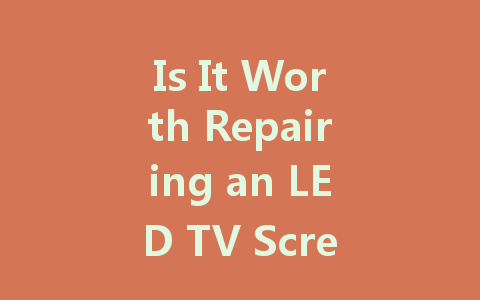
When your LED TV screen sustains damage, it can be a frustrating experience. You might find yourself standing in front of the blackened screen, contemplating whether it’s time to repair or replace your beloved television. In this article, we will explore the pros and cons of repairing an LED TV screen to help you make the best decision.
Understanding LED TV Screens
Before delving into the repair debate, it’s essential to understand what an LED TV screen is. LED, or Light Emitting Diode, televisions use backlighting technology to illuminate the screen, providing brighter colors and sharper contrasts than their LCD counterparts. They are popular choices in homes today due to their sleek designs, energy efficiency, and improved picture quality.
Despite their advantages, LED screens are not impervious to damage. Common issues include cracks, dead pixels, and backlight failures, often leading to headaches over whether to invest in repairs.
The Pros of Repairing an LED TV Screen
One of the primary reasons owners consider repairing their LED TV screens is the potential cost savings. Depending on the extent of the damage, repairs can be significantly cheaper than buying a brand-new television. For instance, replacing a cracked screen can usually be done for a fraction of the cost of purchasing a new TV.
By opting to repair instead of replace, you are not only saving money but also acting in an environmentally responsible manner. TVs can contribute to electronic waste, and repairing your unit extends its life, reducing landfill contributions.
Some TVs may hold sentimental value. Whether it’s the first television bought together as a couple or a family relic used to watch important events, keeping a beloved TV can be more meaningful than buying a newer model.
If your LED TV is relatively new, it likely has advanced features such as 4K resolution, smart capabilities, or excellent audio performance. These elements may not be easily replicable in newer models at the same price point. Repairing your current TV allows you to maintain access to these superior qualities without adjusting to a new set.
The Cons of Repairing an LED TV Screen
While repairs can be cost-effective, they might still represent a significant expense, especially if multiple issues arise. If the total cost of repairs approaches or exceeds the price of a new TV, it may be wiser to invest in a replacement instead.
LED TVs, like any electronic devices, can develop problems over time. If you repair an older model, there’s a risk of facing more issues shortly. In some cases, continuously repairing an aging TV may lead to escalating costs, turning an initially smart decision into an expensive long-term burden.
Depending on the age of your TV, repairing may not guarantee access to the latest technology. Older models might not support the latest streaming standards or could lack compatibility with new devices, leaving you with outdated technology as newer models keep advancing.
If your television is central to your entertainment setup, having it repaired means you will be without a TV for a set period. The inconvenience can be frustrating for those who regularly rely on their TV for watching shows or playing video games.
Key Factors to Consider
Before deciding whether to repair or replace your LED TV screen, consider the following factors:
Conclusion
Deciding whether to repair or replace your damaged LED TV screen involves weighing the pros and cons carefully. If repairs can restore functionality without exorbitant costs, it may be the best route to take. However, if you face extensive repairs on an older model, it might be time to explore the market for a new TV with up-to-date features. Ultimately, the decision should align with your budget, needs, and preferences. By considering your options, you can confidently make the choice that best suits your situation.